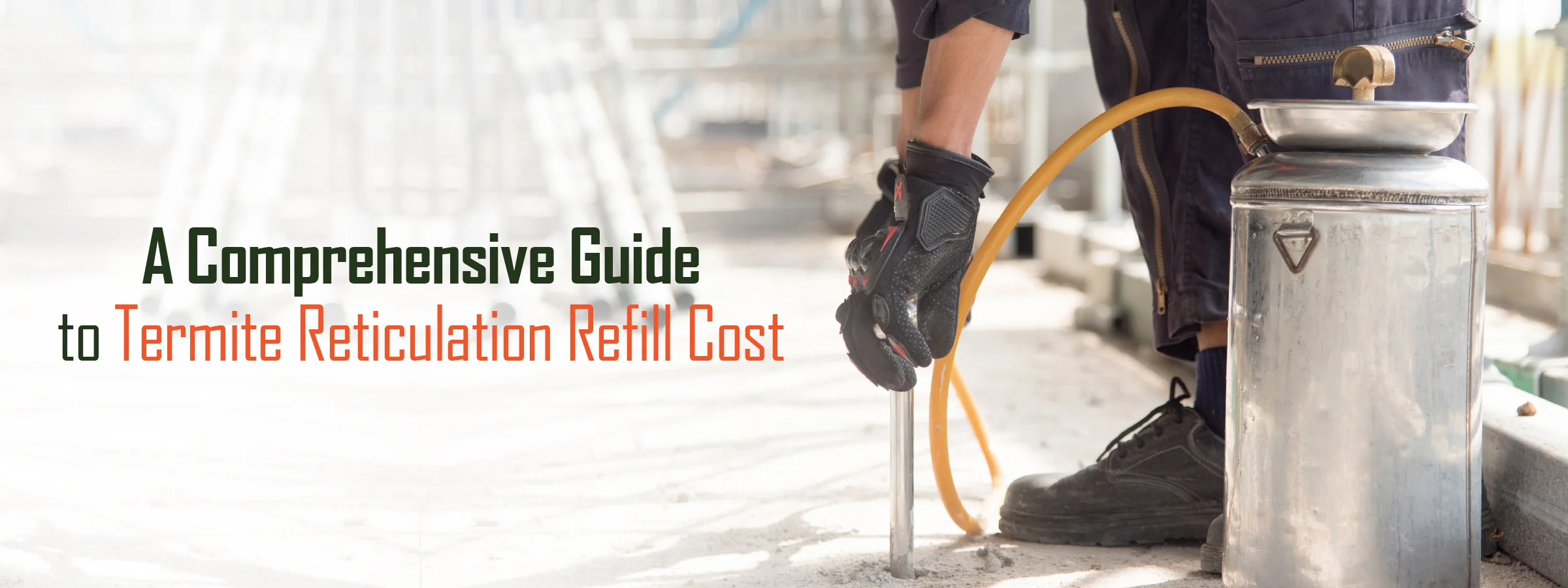
A Comprehensive Guide to Termite Reticulation Refill Cost
Termite infestations can wreak havoc on homes, causing extensive damage and significant financial losses. In the battle against these destructive pests, homeowners often turn to termite reticulation systems for protection. These systems are designed to create a barrier around the perimeter of a property, preventing termites from infiltrating the structure. However, like any other form of termite defense, termite reticulation systems require regular maintenance, including refills of the termiticide solution. In this comprehensive guide, we’ll delve into the details of termite reticulation refill costs, exploring different aspects such as system types, associated expenses, and the importance of regular refills.
What’s a Termite Reticulation System?
A termite reticulation system is a proactive Termite Management System Cost solution that involves the installation of a network of underground pipes around the perimeter of a building. These pipes are perforated to allow the even distribution of termiticide, creating a chemical barrier that deters termites from approaching the structure. The system typically includes a refill point where technicians can replenish the termiticide solution as needed.
Components of a Termite Reticulation System
Termite Reticulation System component from:
1. Perforated Pipes:
The core component of the system, these pipes are installed underground around the perimeter of the building. They have small holes that allow the termiticide to be evenly distributed into the soil.
2. Termiticide Solution:
A chemical solution that is toxic to termites. It creates a barrier that repels or kills termites attempting to enter the treated area.
3. Refill Points:
Strategically placed access points where the termiticide solution can be injected into the system. These points are often positioned in accessible locations around the property to facilitate easy refilling.
4. Pressure Pump (in some systems):
In pressure-injected systems, a pump is used to ensure the termiticide is distributed evenly and reaches all parts of the network of pipes.
Read More: Termite Chemical Barrier Cost

Installation of a termite reticulation system
The installation of a termite reticulation system typically occurs during the construction phase of a building. However, it can also be installed on existing structures. The perforated pipes are laid out in a continuous loop around the foundation of the building, just below the surface level. In some cases, additional piping may be installed under concrete slabs or other vulnerable areas.
Chemical Barrier Creation:
Once the system is in place, the termiticide solution is injected through the refill points. The solution flows through the network of pipes and is released into the surrounding soil through the perforations. This creates a continuous chemical barrier that termites cannot cross.
Refill and Maintenance:
Over time, the termiticide barrier may degrade due to environmental factors such as soil movement, rainfall, and microbial activity. Regular Termite reticulation refill is necessary to maintain the effectiveness of the barrier. The refill points allow pest control professionals to replenish the termiticide solution without disturbing the property.
Get A Free Quote
Feel Free to connect with us
Termite Reticulation System Types
There are several types of termite reticulation systems available on the market, each with its unique features and benefits. Some of the most common types include:
1. Gravity-Fed Systems
Gravity-fed termite reticulation systems rely on gravity to distribute the termiticide solution through the network of underground pipes. The refill point is positioned at a higher elevation to facilitate the flow of the solution into the pipes, allowing it to seep evenly through the perforations and into the surrounding soil.
Advantages:
- Simplicity: These systems are relatively straightforward to install and operate, making them a cost-effective option for many homeowners.
- Lower Installation Costs: Gravity-fed systems typically require less specialized equipment and workers, reducing the overall installation costs.
Disadvantages:
- Uneven Distribution: Gravity-fed systems may not distribute the termiticide as evenly as pressure-injected systems, potentially leading to gaps in the chemical barrier.
- Limited Reach: The effectiveness of the termiticide distribution can be influenced by the terrain and soil conditions, which may limit the reach of the solution in some areas.
2. Pressure-Injected Systems
Pressure-injected termite reticulation systems use a pump to inject the termiticide solution into the network of pipes under pressure. This ensures that the solution is evenly distributed throughout the system, providing a more consistent and reliable chemical barrier against termites.
Advantages:
- Efficient Distribution: The use of pressure ensures that the termiticide is distributed evenly, reducing the risk of gaps in the barrier and enhancing overall effectiveness.
- Enhanced Coverage: Pressure-injected systems can cover larger areas and more complex property layouts, making them suitable for a wide range of applications.
Disadvantages:
- Higher Installation Costs: These systems require specialized equipment and skilled workers for installation, leading to higher upfront costs.
- Maintenance Requirements: Pressure-injected systems may require more frequent maintenance and inspections to ensure that the pump and other components are functioning correctly.
3. Hybrid Systems
Hybrid termite reticulation systems combine elements of both gravity-fed and pressure-injected systems. They offer flexibility in terms of installation and operation, allowing homeowners to benefit from the advantages of both types of systems.
Advantages:
- Versatility: Hybrid systems can be adapted to suit different property configurations and soil conditions, providing flexible solutions for various termite management needs.
- Balanced Cost and Performance: These systems offer a balance between the simplicity of gravity-fed systems and the efficiency of pressure-injected systems, making them an attractive option for many homeowners.
Disadvantages:
- Complexity: The combination of different system elements can make hybrid systems more complex to install and maintain, potentially leading to higher costs and the need for specialized expertise.
- Potential for Inconsistent Performance: Depending on the specific design and installation, hybrid systems may not always achieve the same level of performance as dedicated pressure-injected systems.
Reticulation System Cost
Installing and maintaining a termite reticulation system cost can vary significantly based on several factors including the size of the property, the complexity of the installation, the type of termiticide used, and the geographic location. Here, we break down the various costs associated with termite reticulation systems, drawing on information from reputable sources to give a comprehensive overview.
Installation Costs
The initial installation of a termite reticulation system involves several steps including trenching around the property, laying the pipes, and filling the system with termiticide. The installation of a termite reticulation system cost is generally $14.90 per linear meter. This variance depends on factors such as:
Property Size and Layout:
Larger properties or those with complex layouts may incur higher termite reticulation system refill cost and overall costs due to the increased length of piping required and additional labor.
Soil Type and Condition:
Properties with hard or rocky soil may require more labor-intensive trenching, increasing the termite reticulation system refill cost.
Piping and Termiticide Quality:
Higher quality materials and more effective termiticides can drive up costs but may offer better long-term protection.
For a typical residential property, the total installation cost can range from 1000$ to 4000$ excluding termite reticulation system refill cost. This includes labor, materials, and the initial fill of termiticides.
Read More: how much does a termite barrier cost?
Termite Reticulation Refill Cost
While the initial installation cost is a one-time expense, homeowners should budget for ongoing maintenance costs, including regular refills of the termiticide solution. The termite reticulation refill cost is a crucial aspect and can vary depending on several factors, including the size of the property and the type of termiticide used.
- Size of the Property: Larger properties require more termiticide to treat adequately, resulting in higher termite reticulation refill cost.
- Type of Termiticide: Different types of termiticides are available, ranging in price based on their effectiveness and longevity. Premium products may come with a higher termite reticulation refill cost but offer extended protection against termites.
- Frequency of Refills: The frequency of refills depends on various factors, including the type of termiticide used, environmental conditions, and the presence of termite activity in the area.
- Accessibility: The accessibility of the refill points can affect the termite reticulation refill cost. If the termite reticulation refill points are easily accessible, the refill process is likely to be quicker and more cost-effective.
The frequency of termite reticulation refill generally ranges from every three to five years, depending on factors such as soil conditions, the type of termiticide used, and termite activity in the area.
Cost per Refill: Termite reticulation refill cost typically costs between 300$ and 800$. This termite reticulation refill cost includes the termiticide and labor.
Type of Termiticide: Premium termiticides like Termidor, which are known for their long-lasting effectiveness, may cost more. For example, refilling with a high-end termiticide can be at the higher end of the termite reticulation refill cost spectrum.
Termite Reticulation System Good & Bad
While termite reticulation systems offer effective protection against termite infestations, they also have their pros and cons. Some of the advantages of termite reticulation systems include:

Continuous Protection
Once installed, termite reticulation systems provide continuous protection against termites, offering homeowners peace of mind.

Environmentally Friendly
Many termiticides used in reticulation systems are environmentally friendly, posing minimal risk to humans and pets.

Long-Term Cost Savings
While the initial installation cost may be significant, termite reticulation systems can save homeowners money in the long run by preventing costly termite damage.
However, there are also some drawbacks to consider:

Maintenance Requirements
Termite reticulation systems require regular maintenance, including refills of the termiticide solution, which can add to the overall cost of ownership. The termite reticulation refill cost is an ongoing expense that homeowners need to plan for.

Limited Effectiveness
While termite reticulation systems are effective at preventing termite infestations, they may not eliminate existing termite colonies already present on the property. This means additional measures may be needed alongside the termite reticulation refill cost.

Installation Challenges
Installing a termite reticulation system can be complex and may require excavation around the perimeter of the property, disrupting landscaping and potentially causing damage to underground utilities.
Is There Any Warranty/Guarantee
Many termite reticulation systems come with a warranty or guarantee from the manufacturer or installer. These warranties typically cover defects in materials and workmanship and may also include guarantees on the effectiveness of the system in preventing termite infestations. It’s essential to review the terms and conditions of the warranty carefully and ensure that you understand any limitations or exclusions that may apply, especially regarding the termite reticulation refill cost. Knowing whether the warranty covers the termite reticulation refill cost can help you plan and budget for future maintenance and refills more effectively.
How Often Do These Systems Need to Be Refilled?
The frequency of termite reticulation system refill can vary depending on several factors, including the type of termiticide used, environmental conditions, and the level of termite activity in the area. In general, termite reticulation systems may need to be refilled every 3 to 5 years to maintain their effectiveness. The termite reticulation refill cost is an important factor to consider when planning for these refills. However, homeowners should consult with a qualified pest control professional to determine the optimal refill schedule for their specific circumstances, as this can also influence the overall termite reticulation refill cost.
All in all, termite reticulation systems offer homeowners an effective means of protecting their properties from termite infestations. However, it’s essential to understand the associated costs, including the expense of regular termite reticulation refill of the termiticide solution. To ensure ongoing protection, the termite reticulation refill cost should be factored into your budget. By considering system type, property size, and refill frequency, homeowners can budget effectively for termite reticulation maintenance. Remember to account for the termite reticulation refill cost and consult a qualified pest control professional for personalized advice and recommendations tailored to your needs and circumstances.
Get A Free Quote